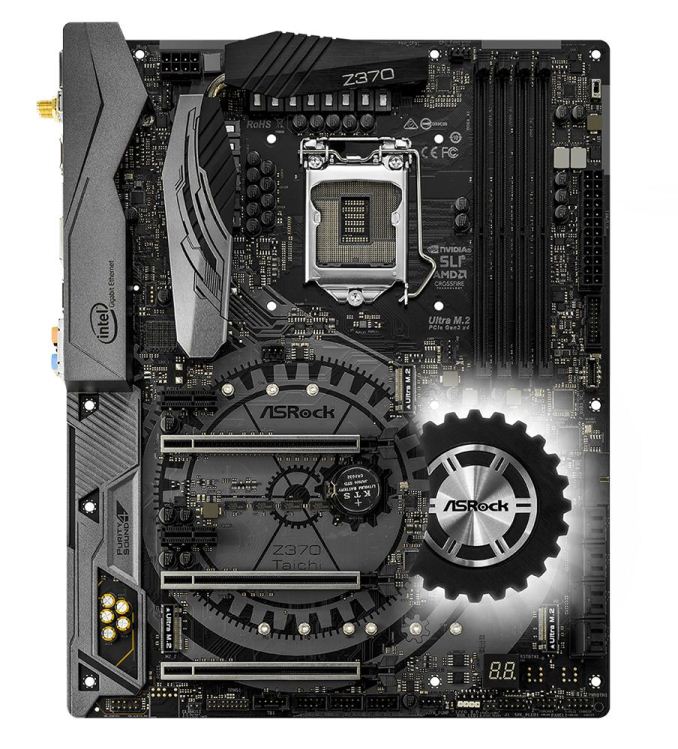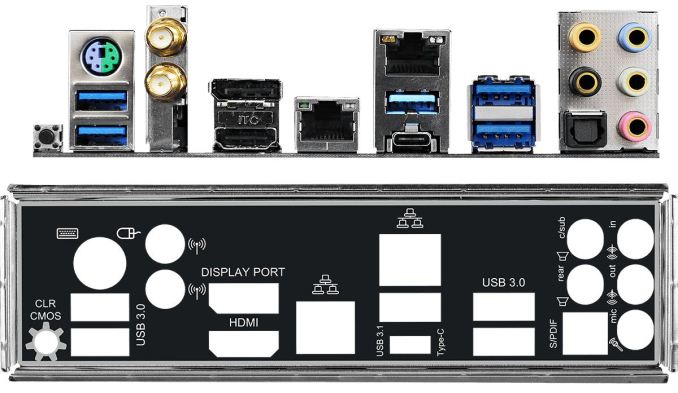Analyzing Z370 for Intel's 8th Generation Coffee Lake: A Quick Look at 50+ Motherboards
by Ian Cutress, Anton Shilov, Joe Shields & Gavin Bonshor on October 20, 2017 2:00 PM ESTASRock Z370 Taichi
In a board that stands in the ASRock's 'upper mid-range' class on its own, the Taichi name lives on another generation in the Z370 Taichi. As with those that came before it, Taichi boards are aimed to be balanced, and do not show a propensity to lean in any which way: gaming, workstation, overclocking, it could (like many other motherboards) do it all. The Z370 version won’t stray from that target either.
The Z370 Taichi looks almost the same as its bigger brother on the X299 platform. The same cog or gear artwork is featured prominently in grey against the all black PCB. The back panel and audio section are covered with the same style shroud from the X299 Taichi. The large VRM heatsinks from the Gaming i7 and Gaming K6 also find their way to the Taichi but in black instead of grey. The chipset heatsink, also in the shape of a gear, is the only place on the board to find RGB LEDs. Users are able to add more color via an LED strip through the onboard header.
The four memory slots provide support for 64GB, with speeds up to DDR4-4333. The Taichi has three reinforced full-length GPU slots, capable of x16 in single card, x8/x8 with two cards, and x8/x4/x4 in three card mode, meaning the board supports both 2-way SLI and 3-way Crossfire. There are also two open-ended PCIe x1 slots, powered from the chipset.
The board offers six SATA ports from the chipset, two SATA ports from an additional controller, and three M.2 slots. The bottom two M.2 devices support up to 110mm while the top supports up to 80mm. The slots do share lanes, so that if the first M.2 slot is populated, SATA 0/1 are disabled. If the second M.2 slot is in use, SATA 4/5 are disabled. Last, if the third M.2 slot is populated by a SATA type M.2 device, SATA3 is disabled, so be aware.
The board has five 4-pin fan headers in various locations around the board to allow for BIOS or F-Stream software control in Windows. The CPU Optional and Chassis Optional pumps both deliver 1.5A/18W to the headers, for powering pumps from AIOs or custom built loops. The same audio found on the higher end boards also made it over to the Taichi via the Realtek ALC1220 codec, and uses Nichicon Gold series audio caps as well as a Texas Instruments NE5532 headset amplifier. Two Intel Ethernet controllers, the Intel I219-V and Intel I211-AT, and an Intel W-Fi module, make up the network side. As with nearly all the ASRock boards, Thunderbolt support is handled by a 5-pin add-in-card connector.
USB connectivity on the back panel IO consists of a USB 3.1 (10 Gbps) Type-A port and Type-C port from an ASMedia ASM3142, as well as four USB 3.1 (5 Gbps) ports from the chipset. A front panel USB 3.1 (10 Gbps) header is found internally, along with three USB 2.0 headers (chipset) and two more USB 3.1 (5 Gbps) headers (ASM1074 hub). The remainder of the back panel IO contains a Clear CMOS button, a combination PS/2 port, DisplayPort and HDMI, and audio jacks plus SPDIF.













83 Comments
View All Comments
sor - Friday, October 20, 2017 - link
Damn. At least key it differently and call it LGA1151v2 or something.The changes are so minimal it really does seem like planned obsolescence. Does it really need more power pins to support new chips with the same power envelopes? Really? They couldn’t handle that on the CPU PCB?
KaarlisK - Saturday, October 21, 2017 - link
Actually it is ~1.5 times peak current with the same average power envelope, so yes, they need the change.If they had not brought the launch forward and just launched together with the cheap chipsets, there would be far less complaints.
sor - Saturday, October 21, 2017 - link
Where did you find information indicating current has increased 50%? I just spent about ten minutes trying to find a reference backing that up, perhaps something indicating the 8 series operates at a much lower voltage within same TDP, which would translate to higher current but they seem to operate in the same 1.2-1.3v range.You’re not just assuming they draw more current because they have two more cores, are you?
KaarlisK - Sunday, October 22, 2017 - link
Notice the difference between average and peak.And the information is in publicly available documents. I did not bother to look it up, but others have, for example: https://forum.beyond3d.com/threads/intel-coffee-la...
Crono - Saturday, October 21, 2017 - link
Nice roundup. That's a lot of motherboards to spec and summarize. I especially appreciate the handy chart at the end, it's a good, quick-and-dirty comparison tool.Landcross - Saturday, October 21, 2017 - link
You guys forgot 2 new Z370 boards from Supermicro :)https://motherboarddb.com/motherboards/?chipset=19...
Xpl1c1t - Sunday, October 22, 2017 - link
The mITX board looks incredible.+ Low ESR Tantalum capacitors! (first time seeing them on VRM duty on a mainboard)
+ HDMI 2.0
+ 2x M.2 Slots
+ USB 3.1 Type C
+ Optical SPDIF
- RGB.......
MadAd - Saturday, October 21, 2017 - link
Great write up but for me its just another depressing generation of oversized, overpriced ATX form factor offerings on which the vast majority of users wont even plug a second gpu into, with the smaller and more size appropriate FF represented as a minority afterthought.With all the progress of PCs since the 90s whod have thought that I could still use the same ATX case today while every single other component (from floppy drives to 2d Mattrox cards) have long gone to the recyclers. I find it so annoying how manufacturers have stuck on this prehistoric gargantuan case size with the other sizes being an afterthought. It feels like like stifled innovation while everything else is moving on.
rocky12345 - Saturday, October 21, 2017 - link
Great article and a lot of work put in to get it out for us to read thank you.My only issue is and it is nit your fault is why these companies feel the need to totally blanket the market with basically the same boards just a different model number and basically a few tiny changes and spray paint it a different color and use the word gaming and put something x or x1 or k,k3 etc etc. For crap sakes just release three models not 7-10 models of the same crap it is pretty much just greed I guess.
The whole market is like this now with anything computer related of and if it has the words GAMING or RGB in it's got to be good for sure. My fav is that gaming mouse pad next it will have RGB lighting in it...lol
CitizenZer0 - Wednesday, October 25, 2017 - link
Agreed